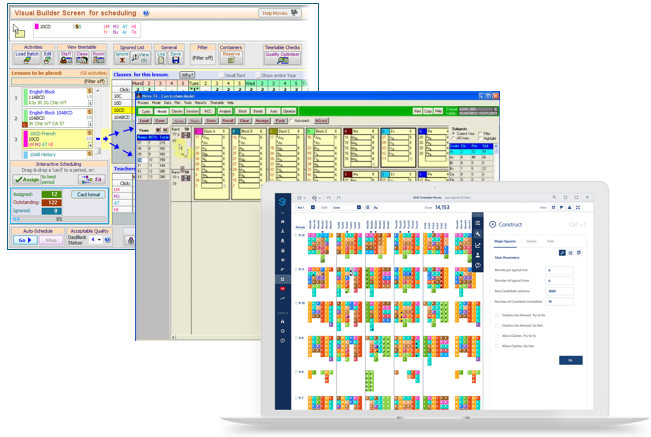In our last post we featured Attendance – today it’s the turn of Timetabling.

If you are thinking of changing your MIS, it is worth checking the various considerations that are needed to be made.
This is the link to our own ‘Considerations‘ blog where you can also download our free document outlining the steps to take
As always, we asked all MIS providers the same questions, and those that replied all included what they offer by way of timetabling.
What we found particularly interesting is that, when we asked common AI engines the following:
“What can you tell me about timetabling systems for UK schools?” two of the three mentioned Timetabler & Nova T.
FYI – We asked MS Co-Pilot, Google’s Gemini & ChatBot GPT

Timetabling systems play a crucial role in organising school schedules, ensuring that classes, teachers, and resources are optimally allocated.
Timetabling systems are software applications designed to efficiently schedule classes, teachers, rooms and resources within a school. These systems aim to optimise the use of available resources while accommodating various constraints such as teacher availability, room capacities, and student preferences.
Here are some key aspects of timetabling systems for UK schools:
Automated Scheduling:
Timetabling software automates the process of creating schedules, which can be a complex task considering the multitude of variables involved. These systems use algorithms to generate schedules that meet the requirements and constraints specified by the school.
Constraints and Preferences:
Timetabling systems allow administrators to input various constraints and preferences that must be taken into account during scheduling. This may include teacher preferences for certain time slots or rooms, subject prerequisites, and student course selections.
Room and Resource Management:
The software helps manage the allocation of rooms and resources such as projectors, computers, and other equipment needed for classes. It ensures that resources are utilised efficiently and that conflicts are minimised.
Integration with, or part of, your School Management Systems:
Below we focus on timetable packages that form part of an MIS, but many other timetabling systems integrate with existing school management software to streamline administrative processes. This integration allows for seamless communication of scheduling information, student data, and other relevant information.
Flexibility and Adaptability:
Timetabling systems should be flexible enough to accommodate changes and adjustments throughout the school year. This includes handling unforeseen events such as teacher absences or changes in student enrolment.
Reporting and Analysis:
These systems often include reporting and analysis tools that allow administrators to evaluate the effectiveness of the schedule and identify areas for improvement. This may involve analysing class sizes, teacher workload, or room utilisation rates.
User-Friendly Interface:
A user-friendly interface is essential for timetabling systems to be effectively utilised by school administrators and staff. Intuitive navigation and clear visualisations help users understand the schedule and make adjustments as needed.
Compliance with Regulations:
Timetabling systems must adhere to regulations and guidelines set forth by educational authorities in the UK. This includes ensuring that schedules meet legal requirements regarding teaching hours, breaks, and other factors.
We asked all MIS providers to let us know if they offer timetabling, and if so, could they let us have a paragraph or two on what they offer, and this is what each of them said:
(For simplicity, we’ve listed the MIS responses in alphabetical order).

Arbor has a full timetable, allowing schools to plan lessons, schedules, exams, rooms, conflicts and classes.
For larger or more complex secondary schools we recommend using industry-leading timetabling tools such as TimeTabler or Edval, and then importing the timetable into Arbor using our built-in import function.

Bromcom supports most school timetable software.
Whether the school uses Nova-T, Edval timetabling or Bromcom’s eTimetable, Bromcom’s MIS will integrate it within its cloud-based platform with these timetable design solutions, ensuring easy access and avoiding any possible disruption.
Bromcom are announcing the full launch of their web-timetabling solution in the coming weeks. As well as being integrated within the MIS – meaning no imports or data syncs are required – Bromcom’s web-timetabling solution is easy to set up using a Project Wizard, and offers numerous features and benefits:
- Timetable Manual and Auto Scheduling, with room view
- Timetable Rules, allowing customisation and control
- Conflict checking, filterable to a selected year group
- Curriculum Plan, with subjects by year group
- Staffing page, with review of availability by subject, department, or teacher
- Relationships Page, and much more!
While the traditional methods for timetabling with Bromcom, such as e-timetable and nova-T will still be supported, the introduction of web-timetabling will significantly reduce admin burden and save countless hours, through Bromcom’s easy to follow navigation.

Timetabling functionality is fully included in the PowerSchool SIS / MIS.
PowerScheduler, as it is called within the SIS / MIS, allows administrators to build out complex timetables based on their own unique needs.
This includes customized course catalogues, different types of schedules (4×4 block, rotating days, inclement weather days, early dismissal days, Saturday school, and more).
Course requests can also be collected from students / families and leveraged when adding students into specific sections.
PowerScheduler includes a full visual scheduler so that administrators can view the schedule on a virtual whiteboard as they work to build and load students into the upcoming timetable.
While only one “master schedule” can happen at a time, administrators have the ability to experiment with multiple scenarios and have full reporting capabilities to ensure that they are optimizing all factors when it comes to effective timetable creation and support.

SIMS is unique in the MIS Market as it has a fully embedded and proven timetabling solution that works with powerful options, academic management, cover management as well as enabling off the academic group functionality within the MIS. The multiple timetables module within SIMS adds another layer of flexibility to our timetable solutions.
Nova T6 saves schools time and resources throughout the school year by completely optimising the timetabling process to ensure there are no clashes, gaps or compromises to learners’ experience.
Key benefits:
- Customisable – meets each school’s needs including extra-curricular activities
- Ease of use – drag and drop interface which schedules automatically based on chosen variables
- Flexible – easily incorporates multiple length lessons and any special arrangements for specific students
- Adaptable – changes can be made throughout the school year

